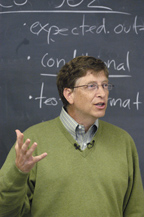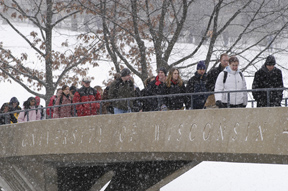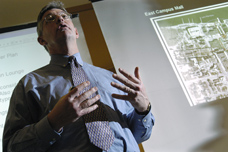
Year in Review 2005–06: Part 2
October 2005

Gates visits class.
The WiCell Research Institute is selected by the National Institutes of Health to establish the federal government’s first and only National Stem Cell Bank, supported by $16 million in funding over four years. Derek Hei, the project’s principal investigator, says the award “is another example of how researchers on this campus work collaboratively and on an interdisciplinary basis.”
During a three-day tour of universities, Bill Gates, chair of Microsoft Corp., visits UW–Madison and speaks to an audience of 200 students about career opportunities in computer science and technology, noting that UW–Madison grad Peter Spiro is one of Microsoft’s key engineers and citing Madison’s potential to be a hub of high-tech business.
The university continues to attract freshman classes made up of talented scholars, athletes, musicians and activists, and the Class of 2009 has a record number of students — 426 — who were first or tied for first academically in their graduating high school classes. Three of those students also received perfect scores on their standardized tests. The freshman class is the most diverse, with the largest number of students of color in the university’s history.

Students represent a full spectrum of talent.
Students in the Applied Security Analysis Program at the School of Business are authorized to manage more than $40 million in fixed-income securities for the UW System — what is believed to be the largest pool of capital managed by students at any American university. When launched in 1970, ASAP was one of the first applied investment programs in the nation. Today the program can claim more than 500 alumni, many in leading investment positions on Wall Street and elsewhere.
A special daylong workshop, Expanding Your Horizons, is held on campus to help middle school girls explore careers and activities in science, engineering and math. More than 65 women representing UW–Madison and other local organizations give presentations and lead hands-on projects in fields including biology, engineering, health and medicine, math and physical sciences.
November 2005

UW officials unveil campus master plan.
A master plan that will guide development of the UW–Madison campus for the next 20 years is detailed by university officials at a public meeting. More than a year in the making, the plan lays out ways to make the campus more livable, workable and sustainable by examining existing and proposed buildings, outdoor spaces, transportation systems and utilities.
Molly Jahn, an expert in plant breeding, gene discovery and genetic mapping of agricultural plants, is named the new dean of the College of Agricultural and Life Sciences. A professor of genetics and plant biology at Cornell University, Jahn says she looks forward to assuming leadership of CALS, which has 2,200 undergraduates, 1,000 graduate students, 270 faculty members and a budget of more than $150 million.
UW–Madison students continue to study abroad in record numbers, according to figures released by the Division of International Studies. The percentage of UW–Madison students on yearlong programs in 2003–04 was 12.3 percent, while the national figure was 6 percent. Campuswide, 58.8 percent of students participated for one full term in 2003–04, compared to the national average of 38 percent.
President George W. Bush names a UW professor of chemical and biological engineering as one of eight recipients of the 2004 National Medal of Science, the nation’s highest honor for science and technology. Hilldale Professor Emeritus of Chemical and Biological Engineering Edwin Lightfoot is honored for pioneering contributions to scientific research and education, becoming the 11th UW–Madison scientist to receive the prestigious award since it was established in 1959.
December 2005
The university and its technology transfer arm, the Wisconsin Alumni Research Foundation (WARF), rank third nationally for the value of inventions created by faculty members during 2004, according to a newly released report. WARF generated more than $47.5 million in licensing, signed more than 200 new license deals and filed more than 300 new patent applications.
Students in the e-Projects in Community Service (ePICS) course present their semester’s work to real-world clients, 12 nonprofit organizations for whom students have designed Web sites, built Web-based information systems, created logos, developed marketing materials and produced videos. Dubbed “Real World 101” by students, ePICS brings together approximately 100 students each semester from engineering, journalism, business and art to work on interdisciplinary teams.
UW–Madison is among the first universities in the country to launch a pilot program requiring companies that produce officially licensed apparel products to purchase 25 percent of their goods from factories that allow a union, representative body or the right of free association for workers. The “designated suppliers program” was first proposed by the national activist group United Students Against Sweatshops to improve the working conditions of apparel workers around the world.
UW researchers tracking changing patterns of agricultural land use around the world find that farmers are now using more than one-third of the Earth’s landscape in a desperate bid to keep pace with the ever-intensifying needs of humans, and that this agricultural activity is emerging as one of the central forces of global environmental change.